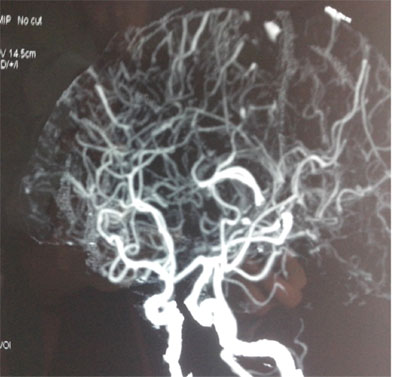|
|
|
Indian Pediatr 2014;51: 323-324 |
 |
Mycotic Aneurysm Rupture in Klebsiella
Endocarditis
|
|
Sumi M Pillai and VK Bharadwaj
Department of Pediatrics,
NSCB Medical College, Madhya Pradesh, India.
Email:
[email protected]
|
|
Damage to the vasa vasorum of blood vessels due to
vasculitis may result in the formation of cerebral mycotic
aneurysm that can rupture and result in massive intra
cranial bleeding. We report an adolescent boy who presented
with hemorrhagic stroke due to ruptured mycotic aneurysm
associated with Klebsiella endocarditis of aortic
valve cusps.
A 14-year-old boy presented with right
hemiparesis and aphasia with a history of fever, joint pain,
palpitations and left sided chest pain. His blood pressure
was more than 95th percentile; fundus examination showed
multiple superficial and deep hemorrhages. He had anaemia,
polymorphonuclear leukocytosis, elevated ESR, elevated ASO
titer and positive C-reactive protein. Blood culture
reported growth of Klebsiella pneumoniae. Renal
profile, coagulation profile and renal doppler studies were
normal; anti-nuclear antibodies were negative.
2D and M-mode echocardiography revealed
eccentric closure of aortic valve cusps suggestive of cusp
damage and moderate aortic regurgitation. There were
vegetations involving anterior aortic valve extending into
left ventricle. Brain computed tomography (CT) revealed
intra-cerebral bleed in the left middle cerebral artery
territory. CT angiogram was suggestive of ruptured mycotic
aneurysm with perifocal edema and mass effect (Fig.
1). The patient was managed conservatively with
decongestive measures and intravenous antibiotics for 6
weeks. Neurological status of child improved with residual
paresis at the time of discharge.
 |
|
Fig. 1 CT angiogram
demonstrating intracerebral bleeding in the left
parieto-occipital lobe with outpouching in the
distal branch of left middle cerebral artery
suggestive of ruptured mycotic aneurysm.
|
Mycotic aneurysm rupture often has a
disastrous clinical course in which morbidity and mortality
can be reduced by early diagnosis and appropriate
antimicrobial therapy [1,2]. Klebsiella endocarditis,
though rare, can have far more devastating consequences [3].
Current management options for mycotic aneurysm include
medical, surgical and endovascular therapy. Solitary mycotic
aneurysm is known to resolve with medical therapy and
surgical intervention is reserved only when these are
multiple, enlarging or not responding to conservative
treatment [4].
Acknowledgements: Dr Sachin Mukundan
Unny and Dr Monika Lazrus.
References
1. Singla V, Sharma R, Nagamani AC,
Manjunath CN. Mycotic aneurysm – A rare and dreaded
complication of infective endocarditis. BMJ Case Rep. 2013;
doi 10.1136/bcr-2013-200016.
2. Regelsberger J, Elsayed A, Matschke J,
Lindop G, GryzyskaU, Vanden Boom L, et al. Diagnostic
and therapeutic considerations for "mycotic" cerebral
aneurysms: 2 case reports and review of the literature. Cent
Eur Neurosurg. 2011;72:138-43.
3. Anderson MJ. Tanoff EN. Klebsiella
endocarditis: Report of two cases and review. Clin Infect
Dis. 1998;26:468-74.
4. Venkatesh SK, Phadke RV, Kalode RR,
Kumar S, Jain VK. Intracranial infective aneurysms
presenting with haemorrhage: An analysis of angiographic
findings- management and outcome. Clin Radiol.
2000;55;946-53.
|
|
|
 |
|

